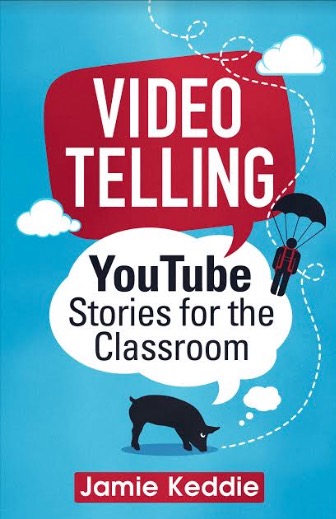Welcome to a new series where we feature great books for language learners and teachers. This month we are featuring the book, Videotelling: YouTube Stories for the Classroom by Jamie Keddie. Videotelling is available for purchase here and on Amazon. Jamie Keddie is a teacher, trainer, storyteller and online video enthusiast. He is the author of two other books with Oxford University Press: Images (2008) and Bringing Online Video into the Classroom (2014). Jamie has been giving talks and workshops on the subject of videotelling since the early days of YouTube. But what exactly is videotelling? And why is it relevant to teachers?
In this post, Jamie explains everything and gives us 8 reasons why you need Videotelling in your classroom.
- Videotelling is an everyday human activity
At its simplest, videotelling (small ‘v’) is putting video narratives into words. This is something that we do all the time in informal conversation. For example, imagine a friend telling you about a funny TV advertisement, a shocking piece of news footage, or a funny video from YouTube.
My own father is a great videoteller. Here he is telling us about his favourite YouTube video of the moment:
https://www.youtube.com/watch?v=TsdY7VXX0VU
And here is the video that he described:
https://www.youtube.com/watch?v=rDF0ibR__Lc
- Videotelling is a book of interactive stories for the classroom
Each story in Videotelling (big ‘V’) is based on the narrative of a short online video. Stories are designed to be read aloud by the teacher. Here is an example story called Splat!. I have included the questions that you would ask your students:
Gavin and Daniel are at work. They are sitting at a table. They are sitting opposite each other and they have their eyes tightly shut.
Can you guess what Gavin and Daniel do for a living? (Possible answers: wine tasters, psychics, arm wrestlers.)
There is a good reason why they have their eyes tightly shut. Above the table, in the space between them, there are thousands of pieces of red flesh, green shell and drops of juice. This is exact moment at which the watermelon exploded.
Can you explain how they caused the watermelon to explode? (Clue: they used 500 identical everyday objects.)
The answer is given below – read on!
3.Videotelling is a reversal of the norm
The traditional way to use video in the classroom is to watch the video first and talk about it later. The stories in Videotelling reverse that process: Questions, discussion, and analysis come first. A full viewing of the video comes later. In this way, technology takes a backseat and human communication comes to the front of the class.
For example, after students share their theories about how Gavin and Daniel caused the watermelon to explode, you can show them the video below and tell them that Gavin Free and Daniel Gruchy are YouTubers, better known as the Slow Mo Guys.
www.youtube.com/watch?v=PK8dsAeMmPk
Note: All videos that are referred to in the book can be accessed at the accompanying website: http://videotelling.com/resources/
- Videotelling is excellent for encouraging students to think critically about the videos in their lives
One of the sections in Videotelling is titled Media Literacy and Critical Thinking. This section contains stories, tasks and questions which are designed to raise students’ awareness of ideas such as stereotyping, video-editing techniques, and relationships between the social and mainstream media.
- Videotelling is an excellent resource for English language teachers
The immersive stories in Videotelling engage English learners of all ages. They balance intensive listening with conversational skills. Throughout the book, there are suggestions for teaching grammar and vocabulary. Additionally, an appendix at the back provides teachers with information about what level of language learner each story is suitable for.
- Videotelling is an excellent resource for CLIL teachers
Many of the story activities in Videotelling can be integrated into subject areas such as art, science, mathematics, media studies, film studies and more. Throughout the book, suggestions are provided for making connections with these subjects.
- Videotelling includes ideas and tasks for students to become videotellers
Many of the stories in this book include follow-up suggestions for students to prepare their own videotelling stories based on their own favourite YouTube videos. There are also ideas for students to create and share ‘talking head’ videos of their own.
- Videotelling is a resource for teacher development
The book contains a wealth of tips and suggestions for working on your own storytelling techniques and video making skills.
Videotelling: YouTube Stories for the Classroom (Lessonstream Books, 2017) is currently available as an ebook. The paperback will become available on amazon.com in the next few weeks. To find out more, visit: videotelling.com
Each week we scour the internet to find incredible books to highlight on our various social networks (@TESOL, @AmericanTESOL, and @ESLWebinars). Check out our past favorites here.
To learn more about integrating technology to support English language learners, attend our free Friday webinars.

